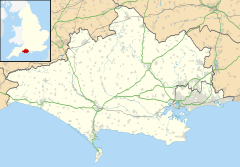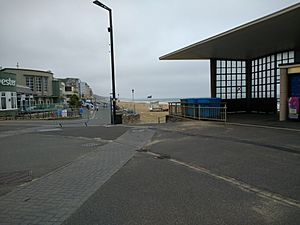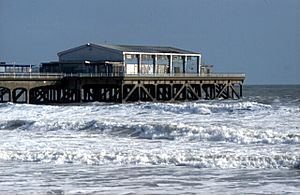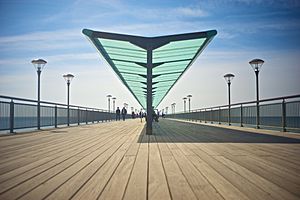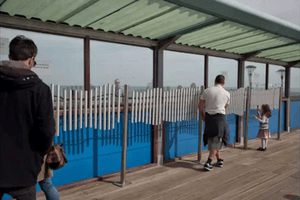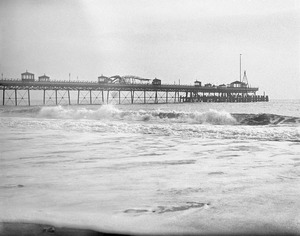Boscombe facts for kids
Quick facts for kids Boscombe |
|
|---|---|
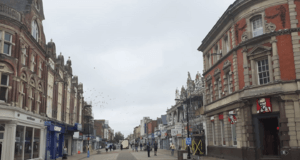 Boscombe High Street |
|
| Population | 20,719 (2 wards, 2011) |
| OS grid reference | SZ115920 |
| Unitary authority |
|
| Ceremonial county | |
| Region | |
| Country | England |
| Sovereign state | United Kingdom |
| Post town | BOURNEMOUTH |
| Postcode district | BH1, BH5 |
| Dialling code | 01202 |
| Police | Dorset |
| Fire | Dorset |
| Ambulance | South Western |
| EU Parliament | South West England |
| UK Parliament |
|
Boscombe is a lively area located in Bournemouth, England. It's found to the east of Bournemouth's town centre and west of Southbourne. It used to be part of Hampshire, but now it's in Dorset.
Long ago, Boscombe was mostly open heathland with very few people living there. But around 1865, it quickly grew from a small village into a popular seaside resort, just like Bournemouth. Its first pier, a long walkway stretching into the sea, opened in 1889.
You can see many different building styles in Boscombe. There's the fancy Victorian style of the Royal Arcade, cool Art Deco buildings like the old Gas & Water Company store, and modern 1950s designs on the pier. There are also new apartment buildings like The Reef and Honeycombe Beach.
Contents
What is Boscombe Like?
Boscombe is located on a large area of heathland. This land once covered much of western Hampshire and eastern Dorset. From the beach and cliffs, you can see all of Poole Bay. This bay stretches from Hengistbury Head in the east to Poole Harbour in the west. You can also see Studland and Swanage bays to the south.
Boscombe was once a separate town, surrounded by woods and moorland. It became part of Bournemouth in 1876. Many Boscombe residents did not want this to happen.
A Look Back at Boscombe's History
The name "Boscumbe" was first mentioned in 1273. It might come from old English words meaning 'a valley with spiky plants'. This could refer to gorse, a thorny bush common in the area.
In the early 1800s, Boscombe was mostly open land. It was known as a place where smugglers might hide. An old inn called the 'Ragged Cat' opened in 1850. It changed names a few times but was called 'The Ragged Cat' again in 2009 before closing. Today, a Polish market is in this historic building.
The Story of Boscombe Manor
In 1801, a house called Boscombe Cottage was built for Mr. Phillip Norris. The estate grew to about 17 acres. This property became the main part of the Boscombe Manor Estate.
The estate changed owners several times. In 1849, Sir Percy Florence Shelley bought it. He wanted it to be a home for his mother, Mary Shelley, who wrote Frankenstein. Sadly, she passed away in London in 1851. Sir Percy and his wife loved the place and made it their home.
Sir Percy rebuilt and expanded the house. He added a large theatre that could seat 200 people, later 300. The architect was Christopher Crabb Creeke. He also designed many roads and buildings in Bournemouth.
The name of the house changed over time. It was Boscombe Cottage, then Boscombe Alcove, then Boscombe Lodge. By Sir Percy's time, it was Boscombe House, and later Boscombe Manor. Today, it is called Shelley Park. Most of the building is now the Shelley Manor Medical Centre.
Sir Percy planted many trees on the estate. There was a drive to the house from Christchurch Road, which is now Chessel Avenue. Another entrance was from Sea Road, along what is now Percy Road.
By the early 1860s, Boscombe was just the Shelley estate and a few cottages.
How Boscombe Grew
From 1865 onwards, Boscombe grew very quickly. The Malmesbury Estate planned to develop a 'picturesque Village of Boscombe Spa'. They wanted to sell land for building homes.
The "Spa" was a natural spring with mineral water. It was thought to have healing properties, like the water in Harrogate. People could come to drink the water and enjoy the sea air.
This plan didn't happen exactly as intended. Instead, Sir Henry Drummond Wolff bought about 19 acres of land. He built a house called Boscombe Towers in 1868. Sir Henry helped develop 'Boscombe Spa' to compete with Bournemouth. He also created the Boscombe Chine Gardens. A small hut was built over the spring, and it became a popular meeting spot.
In 1871, 212 people lived in 19 houses in the Boscombe Estate. Another 70 people lived in 9 houses at Boscombe Spa. By 1881, the population had grown to 1,895 people, a huge increase!
In 1875, a large water tower was built in Palmerston Road. At this time, Boscombe had 244 houses. In 1877, the Royal Boscombe Hospital opened with 12 beds. In 1883, Pokesdown station opened.
Boscombe Pier opened in 1889 (more on that below!). The town centre got a big boost from projects by Archibald Beckett. These included shops, the Salisbury Hotel, the Royal Arcade, and a Grand Theatre. The theatre later became the O2 Academy. These buildings were all built between 1888 and 1895. The Royal Arcade even had electricity in 1892!
Boscombe railway station opened in 1897. The Burlington Hotel, a large hotel with 200 bedrooms, opened in 1893. By 1900, most of the Shelley estate had been sold. Boscombe Chine gardens were also finished. Lady Shelley gave four acres of land before she died in 1899. This land became Boscombe Cliff Gardens. In 1901, the population was 9,648.
Boscombe in the 20th Century
To celebrate the coronation of King Edward VII in 1902, Bournemouth Council renamed a common area "King's Park". Boscombe became very popular as English seaside holidays grew. Between the World Wars, Boscombe was one of Bournemouth's richest areas. It had many large Victorian and Edwardian houses.
In 1935, construction began on the San Remo Towers. This building has 164 flats and was designed in a Los Angeles Spanish style. After World War II, seaside holidays boomed again. Boscombe, with its many small guest houses, did very well. However, Boscombe railway station closed in 1965.
In the 1970s and 1980s, traditional English holidays became less popular. Boscombe's luck started to change. Many small guest houses and large family homes became HMOs, which are houses shared by many different people.
In 1990, to help the shopping centre, Christchurch Road was made into a pedestrian-only area. The Sovereign shopping centre also opened. In 1993, most of the Royal Victoria Hospital was taken down. A new hospital, the Royal Bournemouth Hospital, had opened in 1989.
Boscombe Today
New building plans for the area around Boscombe were approved in 2006. This project aimed to turn the seafront into a "spa village." It included an artificial surf wave created by the Boscombe Surf Reef. The reef was finished in 2009. However, it did not work as well as planned. In 2011, the reef was closed for safety. In 2014, it was renamed a Coastal Activity Park.
Many new flats have been built, like "The Reef" and the renovated Shelley Park. In 2007, a flat in Boscombe sold for £1 million for the first time. Boscombe gardens were also updated. A public art trail was added around Boscombe as part of this project.
Boscombe is sometimes called Bos Vegas. This nickname is even used in the names of some local businesses.
Boscombe is home to AFC Bournemouth, a football club that plays at Dean Court. Many fans still call the team "Boscombe." This is because the club used to be called Boscombe St John's and Bournemouth & Boscombe Athletic FC. The word "Boscombe" was dropped in 1972.
There is a busy street market on the High Street on Thursdays and Saturdays. There is also a vintage market on the first Saturday of every month.
Schools in Boscombe
In the 1870s, a small school at St Clement's Church was too small. So, the Boscombe British school was started by Mr. Frederick Moser and Sir Percy Florence Shelley. The school opened in 1879. It was built in a Neo-Gothic style in Gladstone Road. Later, it became St. John's Church of England Primary School.
The older students moved to the new Boscombe Bilateral Secondary Modern school in 1940. This school is now King’s Park Primary. In 1960, a teacher named Leslie Williams started the 'Bournemouth Children's Theatre' in the old school buildings. It became the Drama Centre. Dame Sybil Thorndike, a famous actress, supported the centre and visited often.
In the 1980s, the Drama Centre became the Bournemouth Centre for Community Arts (BCCA). This was to include more types of art. Gareth Malone, a well-known choirmaster from BBC shows, attended the BCCA. The BCCA closed in 2007. People tried to save the building from being taken down. English Heritage listed it as a Grade II listed building in 2008. This meant it was protected because of its Gothic design.
In 2012, permission was given to restore some rooms and build 11 affordable homes. This was despite many objections. In 2013, the demolition of parts of the BCCA began. Protesters even held a mock funeral to try and stop it.
The Religious of the Cross ran a Roman Catholic school for girls and later for boys. It was built in 1889. This building has been home to the Anglo-European College of Chiropractic since 1982.
Other schools in Boscombe include St James's Church of England Primary, Corpus Christi Catholic Primary (next to Corpus Christi Church), Bethany Primary, Portchester, and Avonbourne comprehensive schools.
Boscombe Beach and Spa
Boscombe Beach is a lovely stretch of coastline.
Boscombe Chine is a valley that runs through the sandy cliffs. It collects water from several small valleys. The southern part of the chine was made into pretty gardens. A natural spring of mineral water was found near the bottom of the Chine. A small hut was built over this spring and called Boscombe Spa. People would visit to drink the water, hoping it would improve their health.
Boscombe Pier: A Walk Over the Sea
A pier was first suggested in 1884 to attract visitors. Building started in 1888. The pier was 200 yards long and 11 yards wide. It had a landing stage on each side for boats. At the entrance, there were two toll houses. The architect was James Stuart Campbell McEwan-Brown. The Duke of Argyll officially opened the pier on July 29, 1889.
The pier head, the wider part at the end, was added in 1926. Like many piers, it was partly taken down during World War II. This was to stop enemies from landing there. The pier was left unused for many years. It finally fully reopened in 1962. The entrance building was designed in a modern 1950s style. This building was Grade II listed in 2004. This means it is an important historic building.
The building at the end of the pier was first a theatre, then a roller skating rink, and later an amusement arcade. It closed in 1989. The pier then became run down for 19 years.
On October 30, 2005, the pier was closed because it was unsafe. The entrance building was restored in 2007. New decking, lights, and a windbreak screen were added. A new viewing and fishing platform replaced the old amusement hall. The pier reopened in May 2008. To the east of the pier is Europe's first artificial surf reef.
Since the pier reopened, a Friends Association has been formed. They organize art shows and live music. In 2009, a website called it Britain’s coolest pier. The National Piers Society voted it Pier of the Year 2010.
In 2014, a musical walkway was added to the pier. It has 88 special chimes that play ‘I Do Like To be Beside the Seaside’ when you hit them in the right order. It includes tubular bells and other musical instruments.
The pier also has its own fishing club, The Boscombe Pier Sea Anglers. It was started in 2002 for fishing outside of regular hours.
| Awards and achievements | ||
|---|---|---|
| Preceded by Saltburn Pier |
National Piers Society Pier of the Year 2010 |
Succeeded by Grand Pier, Weston-super-Mare |
The Boscombe Devil
The Boscombe Devil is a strange-looking statue on a building. It faces the Boscombe Grand Theatre (now the O2 Academy). It was put there in the 1920s by a group called the Lord's Day Observance Society. They wanted to show they did not approve of the theatre opening on Sundays.
How Boscombe is Governed
Boscombe is divided into two areas for local elections. These are Boscombe East and Pokesdown and Boscombe West. Each area elects two councillors to the Bournemouth, Christchurch and Poole Council.
Boscombe is also part of the Bournemouth East parliamentary area. This is for elections to the House of Commons of the United Kingdom.
Images for kids


